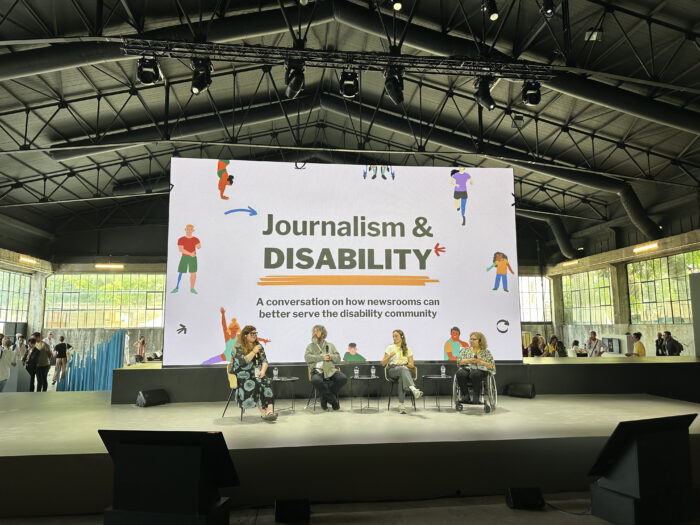
Athens — Despite the fact that an estimated 1.3 billion people around the world experience some form of disability, newsrooms are “woefully unprepared” to serve audience members or employ journalists with disabilities, according to journalists on a panel on Thursday at the IMEDD International Journalism Forum in Athens, Greece.
The panel featured three journalists living with disabilities — BBC special projects digital producer Johny Cassidy, Times Radio [UK]’s multimedia reporter Joanna Crawford, and retired Greek journalist Korina Theodorakaki — and was moderated by Hannah Wise, the Kansas City Star’s assistant managing editor for engagement and experimentation.“If our goal is to provide information to all audiences and all people in our community, we must make our news products accessible,” Wise said. “We must make our newsrooms accessible and inclusive, and we must represent disabled people in our work.”
THIS 👏 #imeddijf23 pic.twitter.com/wqQDT6Bvpy
— Enrique Anarte (@enriqueanarte) September 28, 2023
Journalists and media companies need to be able to talk about disabilities openly to be able to make changes, the panelists said.
“When I first got sick [with Crohn’s disease], it was my editor who took me to the emergency room and stayed with me until my father could come from six hours away,” Wise recounted. “The fact that he was going to be supportive of me and that [the company would do its] homework to understand more about Crohn’s disease and how they could support me, it was huge. I stayed working at the Dallas Morning News far longer than I initially planned because of that safety and security that I felt.”
Journalists with disabilities, their colleagues who don’t have disabilities, and their employers also need to be equipped to change their mindsets and talk about disabilities accurately and with care, both to each other and with their audiences. Theodorakaki, who is living with paraplegia and uses a wheelchair, explained that [in some languages], people use the word “wheelchair” to describe both chairs for people with disabilities and baby strollers.
“Words carry mentalities,” Theodorakaki said. “The way we choose to refer to a person with a disability hides an entire mentality…Precision matters.”
Cassidy co-chairs BBC Ability, the network’s group for staffers living with disabilities. Day-to-day, he said, newsrooms need to prioritizing digital product accessibility for disabled journalists, starting at the beginning of product development.
“Accessibility considerations [usually come] at the end,” Cassidy said. He added, “We should be building tools that makes it easier for journalists to create accessibility…I’m really excited about what AI could do [for accessibility]. But before we get there, it’s about making sure that the tools that journalists are given are accessible — and designed with people like me in an advisory role.”
So pleased to be invited to talk at the @iMEdD_org International Journalism Forum in Athens to discuss why all newsrooms need to do more to recruit and retain disabled journalists. Loads of progress but still so much work to do. A great panel. pic.twitter.com/bFWR4PW9Yz
— Johny Cassidy (@johnycassidy) September 28, 2023
Crawford, who has dyslexia, dyspraxia, and ADHD, said that as a multimedia reporter, she breaks down complex topics visually, allowing her to serve a broader audience.
“I create videos for social media that get millions of views on multiple occasions,” Crawford said. “It’s appealing to a wide range of people who perhaps struggle with mainstream media formats. I would say that’s one of the biggest reasons why we should invest our resources into bringing more neurodiverse people into newsrooms.”
When one audience member asked if there were media companies that are doing this well, Wise noted that TikTok was one of the first platforms that she saw prioritize accessibility, with, for instance, an auto-caption function.
Cassidy noted that LinkedIn is overhauling its features to include text-to-speech tools and “content isolation” to make busy pages less distracting. If tech companies can do that, Wise suggested, newsrooms should be able to do the same.
The IMEDD International Journalism Forum is hosted by the Greek nonprofit Incubator for Media Education and Development. You can watch the livestream of this year’s conference here.